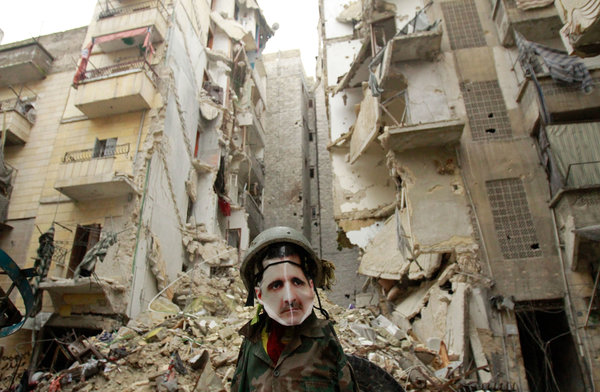This photo was front page above the fold at the New York Times, and for good reason: it’s a work of public art.
Two works, actually: an effigy of Syrian president Assad and the photograph framing it with an apartment building gashed in two by bombing. The building is in the war zone formerly known as the city of Aleppo.
The effigy might have been made by an artist or by some kids on the street, and the photograph might have been taken by an old pro or a young stringer. Doesn’t matter. Both are skillful and work in the same direction, while the photograph relays and adds something to the stuffed figure to bring out its full artistic potential.
And what a statement that is. Comically askew helmet and uniform on a ruler who takes no risks while having others do his killing for him; photographed face on a dummy’s body for a man who hides behind an authoritarian screen of authority; a hunched, wary, remorseless attitude that allows his society to be torn apart as he turns his back on the suffering. . . . the vernacular artist has eloquently captured this vicious martinet’s lack of flexibility, legitimacy, empathy, and shame.
The photograph adds to the composition by making the connection between the tyrants’ personality and the damage done to the nation. We can easily imagine that Assad might some day stand over a country in which every building has been razed, only to say, “but I’m still in power.” And that is what photography is supposed to do: extend the imagination. Photojournalism in particular is there in part to extend the political imagination, allowing us to see how the future might be already evident in the present. Evident, for example, in the character of the leader, and in the suffering, knowledge, skill, and resolve of the people.
Art works by allusion as well, in this case to the Chaplinesque figure of the Great Dictator, who was really a little dictator. And so it is in Syria: the great man is really very small, and 60,000 people are dead because he doesn’t have a larger heart or mind. But there is another point to be made here as well, which is that this distortion in magnitude is one that is best captured by small arts. Arts like the effigy and the photograph, for example.
Great leaders, like great moments in history, may require more panoramic media to be adequately represented. But when a petty despot is leading his people into the slaughter pen, the grand painting or sweeping film won’t do. Leadership is one thing, criminality another. Fortunately for modern times, we have the arts we need.
Photograph by Agence France-Presse/Getty Images.
The photo accompanied this story at the Times.

Discussion